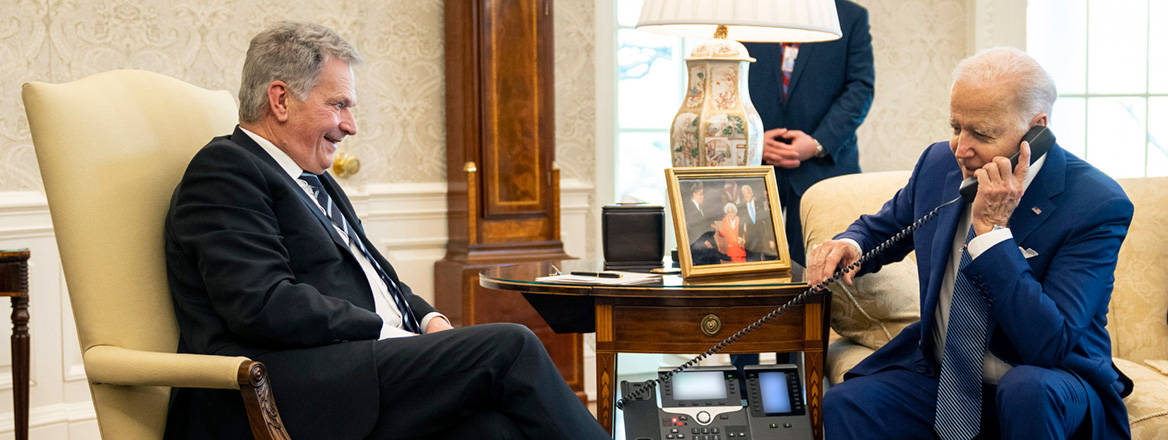Finland and Sweden’s Path Towards NATO
The failure of deterrence and the outbreak of war in Ukraine should be a wakeup call to the Nordic governments to create a more robust and coherent deterrence and defence posture across the region. To ensure security and stability, all the states on Russia’s northwest flank must further advance the regional agenda from intertwined tactical and operational defence cooperation towards more a compelling deterrence strategy.
Almost three decades after Finland and Sweden entered into a partnership with NATO, recent opinion polls show a significant increase in the number of Finns and Swedes favouring membership. The Finnish government will release a white paper in April addressing its security policy options, including alliance membership, while the Swedish prime minister, Magdalena Andersson, has deferred the membership question in anticipation of a security policy review due in late May. The momentum for joining NATO is stronger in Finland.
The Nordic countries share a similar set of challenges, and they already cooperate extensively on security and defence. While Denmark, Iceland and Norway are NATO members, Finland and Sweden are Enhanced Opportunities Partners (EOP) and participate in a number of NATO arrangements, including the NATO Response Force. They have also signed Host Nation Support agreements with the alliance. Shortly after the outbreak of the war in Ukraine, NATO’s Secretary-General Jens Stoltenberg announced strengthened cooperation, information sharing and consultations with the two Nordic partner countries, Finland and Sweden.
All Nordic states consider the US as the prime guarantor of regional security and stability and have separate bilateral agreements on security and defence cooperation with the US. The US Air Force and US Marine Corps have prepositioned equipment in Norway. However, the Marine Corps has used this equipment for participation in exercises in Finland and Sweden as well as Norway. All Nordic countries support or exercise with US Air Force units, while the US Army and Navy have both increased their activity in the High North in recent years.
The pivotal role played by the US in Finnish and Swedish security policy was clearly illustrated by a series of meetings held in the days following the Russian invasion of Ukraine. On 4 March, Finnish President Sauli Niinstö met with US President Joe Biden in the White House to discuss closer cooperation on security and defence. The following day, a bilateral meeting was held in Helsinki between Finland’s prime minister, Sanna Marin, and Sweden’s prime minster. Finland and Sweden decided to cooperate more closely with NATO and in addition to improve their existing collaboration with the US by seeking to attain a ‘Major Non-NATO Ally Status’.
These developments follow decades of ever-closer Finnish-Swedish cooperation with the US, NATO, and other countries and organisations in the transatlantic and European security order. Regional cooperation with the UK, Denmark, Iceland and Norway has played a crucial role in this transformation. All Nordic countries are members of the UK-initiated Northern Group security forum and Joint Expeditionary Force, alongside NATO members in Western Europe and the Baltics. The UK has a strong historic and current role in enabling stability and security in the Nordic region. Its future role, ambitions and partnerships are depicted in the UK’s recently published inaugural Arctic defence strategy.
Russia’s invasion has shown that Ukraine’s Enhanced Opportunity Partner status is an insufficient deterrent, which adds impetus to the Finnish and Swedish NATO question
The current military cooperation among Nordic states has evolved gradually over the last three decades. Beginning with out-of-area operations in the 1990s, the armed forces of the Nordic countries have cooperated ever more extensively. Both Finland and Sweden have regularly participated in multinational joint winter exercises in Norway, such as the recent Cold Response exercise, while Norway has repeatedly taken part in military exercises in the Baltic region. Additionally, Finnish, Norwegian and Swedish air force units regularly train and exercise together, sometimes with other partner and allied forces. Years of extensive cooperation on exercises, training and operations have resulted in Finnish and Swedish forces being highly interoperable with NATO.
The previous Russian shock to European security – the 2014 Ukraine crisis – led the Nordic countries to intensify their cooperation. Gradually, the scope was widened to include operational plans. The Nordic Defence Cooperation (NORDEFCO) Vision 2025 outlines an extensive agenda for ever-closer cooperation on a wide variety of subjects, including movement and storage of military equipment, situational awareness, and crisis consultations. While the Nordic countries have not committed to formal security guarantees, the relationship is close enough to constitute alignment.
The war in Ukraine has profound implications for Nordic security cooperation. Russia’s invasion has shown that Ukraine’s EOP status is an insufficient deterrent, which adds impetus to the Finnish and Swedish NATO question. Given their interoperable armed forces, the Nordic countries would be able to conduct multinational military action in crisis and war, granted ad hoc political approval. The absence of formal security guarantees based on NATO membership, however, creates strategic ambiguity that undermines the deterrence effect and the preventive value of this collective defence capability. Furthermore, Denmark and Norway can hardly issue security guarantees to Finland and Sweden, as this would constitute alliance membership by proxy. Should Finland decide to join NATO while Sweden stays out, the Swedes could easily find themselves in the same isolated position as Ukraine, should the country fall victim to limited Russian aggression. Only if Finland and Sweden decide to join NATO would the entire Nordic region become part of a comprehensive and robust deterrence scheme to prevent conflict in the High North.
The views expressed in this Commentary are the author’s, and do not represent those of RUSI or any other institution.
Have an idea for a Commentary you’d like to write for us? Send a short pitch to commentaries@rusi.org and we’ll get back to you if it fits into our research interests. Full guidelines for contributors can be found here.
WRITTEN BY
Colonel (Ret'd) Per Erik Solli
Øystein Solvang
- Jim McLeanMedia Relations Manager+44 (0)7917 373 069JimMc@rusi.org



